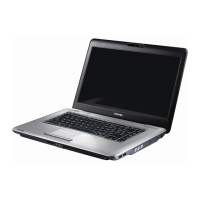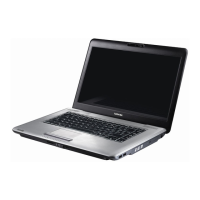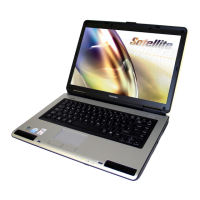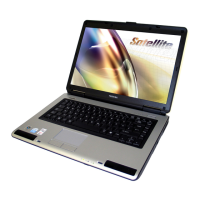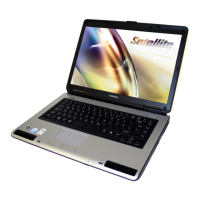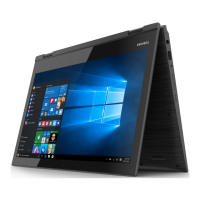
Do you have a question about the Toshiba Satellite L450D series and is the answer not in the manual?
General statements about the manual's accuracy and liability.
Lists registered trademarks mentioned in the manual.
Details FCC compliance notices, conditions, and contact information.
Statement of compliance with European harmonized standards.
Warnings and statements regarding modem functionality and compatibility.
Specific regulations for modem use in Japan, including region selection.
Usage notes and warnings for users in Australia and New Zealand.
Safety guidelines for operating the optical disc drive.
General notices regarding copyright and product usage.
Explains the formatting and symbols used in the manual.
Guidelines for safe and proper use of the computer to prevent injury or damage.
Lists all hardware and software items included with the computer.
Details the pre-installed operating system and utility software.
Lists the accompanying manuals and license agreements.
Describes the computer's hardware components and benefits.
Highlights unique or advanced features for user convenience.
Explains pre-installed TOSHIBA component features and utilities.
Describes pre-installed utilities and how to start them.
Lists optional devices that can expand computer capabilities.
Identifies components on the computer's front when the display is closed.
Identifies components on the computer's left side.
Identifies components on the computer's right side.
Identifies components on the computer's back side.
Identifies components on the computer's underside.
Identifies components when the display panel is open.
Explains the function of various LED system indicators.
Describes the CAPS LOCK and keypad overlay indicators.
Details the computer's optical drive capabilities and region codes.
Provides steps and precautions for connecting the AC adaptor.
Instructions on how to open the computer's display panel.
Steps for powering on the computer.
Guidance for the initial operating system setup.
Explains different modes for turning off the computer.
Describes methods for restarting the computer.
Explains how to use system recovery tools.
Instructions on how to use the Touch Pad and its buttons.
Details on loading, removing, and writing to optical discs.
Explains how to write data to CD/DVD media.
Provides tips for protecting CD, DVD, and floppy diskettes.
Explains the limitations and usage of TOSHIBA Disc Creator.
Guides on making Labelflash DVDs and DVD-Videos.
Covers display settings and audio configurations.
Instructions for using the web camera and its application.
Explains the face recognition utility for logging in.
Details on connecting and disconnecting the internal modem.
Information on setting up and securing the wireless LAN connection.
Instructions for connecting and disconnecting to a LAN.
Guidelines for safely cleaning the computer.
Precautions to take when moving the computer.
Explains how the computer manages heat to prevent overheating.
Describes the basic letter, number, and symbol keys.
Explains the purpose of the twelve function keys.
Details how to use the FN key with other keys for special functions.
Lists hot keys for quick system configuration changes.
Explains how to use the integrated numeric keypad overlay.
Describes power status based on AC adaptor and battery.
Explains the meaning of Battery, DC IN, and Power indicators.
Information on battery types, care, charging, and monitoring.
Instructions for removing and installing the battery pack.
Explains the User and Supervisor password settings.
Describes the computer's three power-up modes.
Overview of the TOSHIBA HW Setup program and its capabilities.
Instructions for setting or resetting User and Supervisor passwords.
Options for customizing display settings for internal or external monitors.
How to set the computer's boot device priority.
Settings related to keyboard functions like Wake-up on Keyboard.
Settings for Wake-up on LAN and Built-in LAN functions.
Information on memory cards and expansion modules.
Instructions for installing and removing memory modules.
Information on additional battery packs, AC adaptors, and chargers.
Details on connecting external monitors and USB floppy drives.
How to connect an external monitor to the computer.
Information on connecting to a TV via HDMI.
How to attach a security cable to prevent theft.
General guidelines for identifying and solving computer problems.
Basic checks to perform before diagnosing a problem.
Lists common hardware and system areas prone to problems.
Checks for issues preventing proper system startup.
Troubleshooting steps for AC power and battery issues.
Explains causes and solutions for computer overheating.
Troubleshooting steps for battery not powering or charging.
Solutions for keyboard-related issues like garbled output.
Steps for resolving hard disk drive issues.
Troubleshooting for problems with the optical disc drive.
Steps for troubleshooting the USB floppy diskette drive.
Troubleshooting for memory card errors.
Solutions for issues with the Touch Pad or mouse.
Troubleshooting for modem communication problems.
Steps to troubleshoot wireless LAN access problems.
Resolving issues with smooth video playback.
Information on how to contact TOSHIBA for technical assistance.
Disclaimer on CPU performance variations.
Requirements and compatibility for 64-bit computing.
Explains how system memory is used and limitations.
Disclaimer on factors affecting battery life and replacement.
Recommendation to adjust LCD brightness for eye comfort.
Specifies operating and non-operating environmental conditions.
Details the AC adaptor and computer power specifications.
Explains how the display controller interprets commands for pixel output.
Details the modem's capabilities and transmission speeds.
Details the form factor, compatibility, and data rates of the wireless card.
Explains factors affecting wireless signal range and performance.
Lists supported frequency bands and channels for wireless communication.
Details the length, wire size, and ratings for AC power cords.
Lists certification agencies for power cords in different regions.
